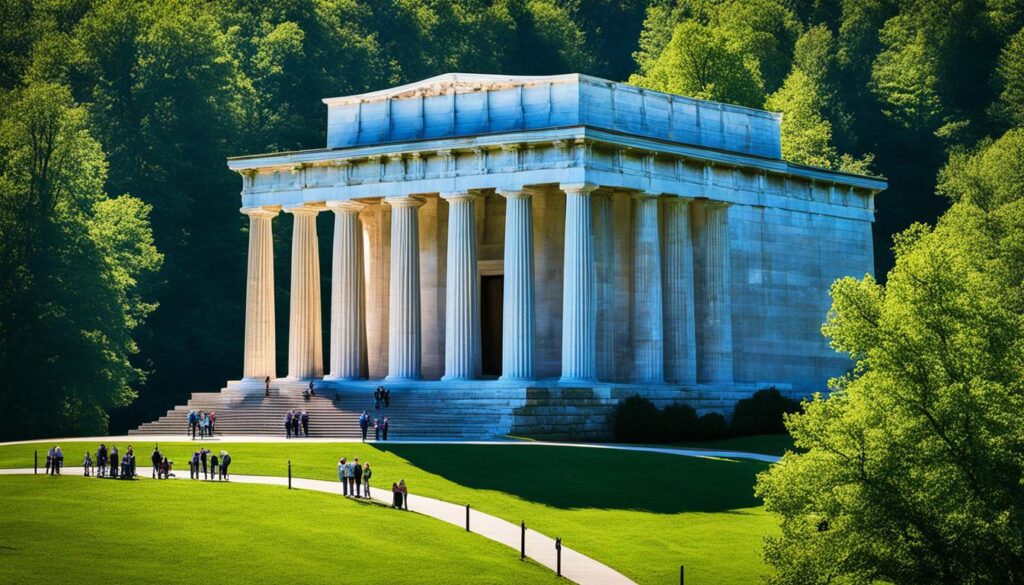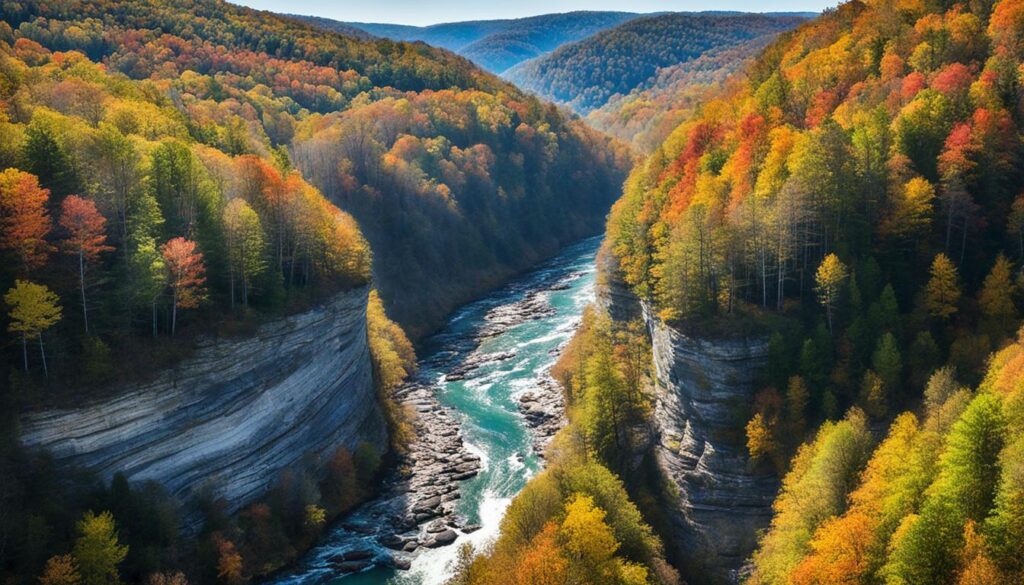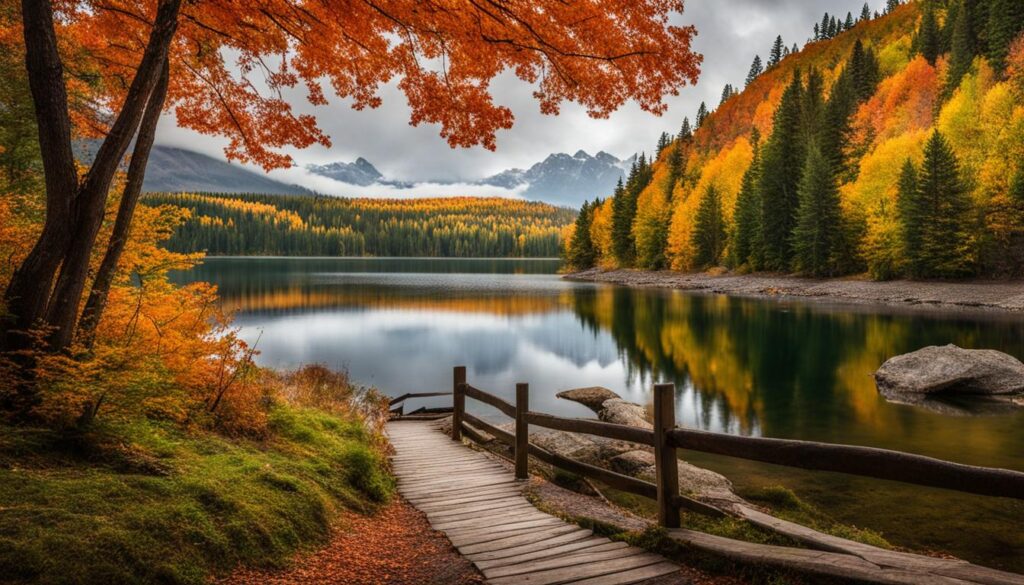Lexington, Kentucky is not only known for its horse breeding but also for its proximity to several stunning state parks. In this article, we will explore six state parks near Lexington that offer a variety of outdoor activities and natural attractions. From hiking trails and camping grounds to picnic spots and wildlife spotting, these parks have something for everyone.
Key Takeaways:
- Explore the natural beauty of Kentucky with these six state parks near Lexington.
- Engage in outdoor activities such as hiking trails, camping, and bird watching.
- Discover the diverse wildlife and natural attractions found in these parks.
- Plan a family-friendly outing to enjoy picnicking and other recreational opportunities.
- Immerse yourself in history at the Abraham Lincoln Birthplace & National Historical Park.
Contents
Abraham Lincoln Birthplace & National Historical Park
Located just a short drive from downtown Lexington, the Abraham Lincoln Birthplace & National Historical Park is a must-visit for history enthusiasts. This park commemorates the birthplace of the 16th President of the United States, Abraham Lincoln. The park features a replica of the log cabin where Lincoln was born, as well as other historic structures and monuments. Visitors can explore the grounds, learn about Lincoln’s early life, and gain insight into his journey from Kentucky to the White House.

Discovering the birthplace of Abraham Lincoln is a truly immersive experience, allowing visitors to step back in time and gain a deeper understanding of the life and legacy of one of America’s greatest leaders. The replica cabin provides a glimpse into the humble beginnings of Lincoln, while the historical structures and monuments offer a rich context for his remarkable journey.
“My paramount object in this struggle is to save the Union, and it is not either to save or destroy slavery. If I could save the Union without freeing any slave I would do it, and if I could save it by freeing all the slaves I would do it; and if I could save it by freeing some and leaving others alone I would also do that.”
Exploring the Birthplace
Upon arrival at the Abraham Lincoln Birthplace & National Historical Park, visitors are greeted by the sight of the iconic log cabin replica. This faithful recreation of the original cabin where Lincoln was born offers a tangible connection to his early years and serves as a tangible reminder of his humble beginnings.
As visitors wander through the park, they’ll also come across other historic structures and monuments that provide further insight into Lincoln’s life. From the symbolic Sinking Spring, where Lincoln was born, to the memorial building enclosing the symbolic birthplace cabin, every corner of the park tells a story.
Journey of a President
Exploring the Abraham Lincoln Birthplace & National Historical Park goes beyond the physical site itself. It offers an opportunity to delve into the life of Lincoln and trace his remarkable journey from Kentucky to the White House.
Through exhibitions, interactive displays, and guided tours, visitors can gain a deeper understanding of Lincoln’s early years and the influences that shaped his character and leadership. They’ll discover how his upbringing in Kentucky shaped his values and principles and how these would guide him through one of the most challenging periods in American history.
A Legacy Preserved
The Abraham Lincoln Birthplace & National Historical Park stands as a testament to the enduring legacy of Abraham Lincoln. It serves not only as a historical site but also as a place of reflection and inspiration, allowing visitors to contemplate the impact of Lincoln’s leadership and the enduring relevance of his ideals.
By preserving the birthplace and its surroundings, this National Historical Park ensures that future generations can continue to learn from Lincoln’s life and draw inspiration from his unwavering commitment to justice, equality, and the preservation of the Union.
| Key Features: | Replica log cabin | Historic structures and monuments |
|---|---|---|
| Location: | 1 Lincoln Farm Road, Hodgenville, KY | |
| Hours: | Open daily from 9:00 AM to 5:00 PM | |
| Admission: | Free | |
| Contact: | (270) 358-3137 | https://www.nps.gov/abli/index.htm |
Big South Fork National River & Recreational Area
For outdoor enthusiasts, the Big South Fork National River & Recreational Area is a paradise. Situated in both Tennessee and Kentucky, this protected area offers over 125,000 acres of rugged terrain, scenic gorges, and abundant wildlife. Visitors can enjoy a wide range of recreational activities including hiking, camping, fishing, kayaking, and horseback riding. With its breathtaking beauty and diverse wildlife, the Big South Fork is a must-see for nature lovers.
Explore the Great Outdoors
At the Big South Fork National River & Recreational Area, there’s no shortage of outdoor activities to indulge in. Hiking enthusiasts will find themselves immersed in a network of picturesque trails that wind through forests, across streams, and along the scenic gorges. From easy strolls to challenging treks, there’s a trail for every skill level.
If you prefer to take to the water, the Big South Fork offers excellent opportunities for fishing and kayaking. Cast your line into the rivers and streams, and you may reel in smallmouth bass, rock bass, and other prized fish species. Paddle your way through the calm waters, marvel at the stunning rock formations, and experience the thrill of navigating the river’s gentle currents.
Horseback riding enthusiasts will also find their piece of paradise at the Big South Fork. The park boasts miles of equestrian trails that are perfect for exploring the rugged landscape on horseback. Saddle up and discover the beauty of the park while enjoying a unique perspective along the trails.
Immerse Yourself in Nature
One of the highlights of the Big South Fork is the opportunity to witness the beauty of its scenic gorges. These deep, narrow canyons carved by rivers over millions of years create a stunning and awe-inspiring landscape. As you hike or ride through the park, you’ll be treated to breathtaking views of these natural wonders at every turn.
Wildlife enthusiasts will be delighted by the abundance of animal species that call the Big South Fork home. Keep your eyes peeled for white-tailed deer, wild turkeys, foxes, and numerous bird species. The park’s diverse ecosystem provides a sanctuary for these creatures, offering ample opportunities for wildlife spotting and bird watching.

Whether you’re seeking adventure or tranquility, the Big South Fork National River & Recreational Area has it all. Plan your visit to this wilderness haven and immerse yourself in the natural beauty and outdoor activities that Kentucky and Tennessee have to offer.
Camp Nelson National Monument
Camp Nelson National Monument is a significant historical site located near Lexington, Kentucky. This park holds great importance in Civil War history, serving as a Union supply depot, training center, and refugee camp during that tumultuous period. It played a crucial role as a major recruitment and training center for African American soldiers, making it a significant site in African American history as well.
Visitors to Camp Nelson National Monument have the opportunity to explore the park’s historic buildings and learn about the experiences of those who lived and fought there. By immersing themselves in this rich history, visitors can gain a deeper understanding of the sacrifices made and the challenges faced during the Civil War.

Civil War Heritage and African American Soldiers
The Camp Nelson National Monument is a testament to the profound impact of the Civil War on American society. It stands as a reminder of the struggles faced by both the Union and Confederate forces, and particularly shines a light on the experiences of African American soldiers during this time.
“The history of Camp Nelson National Monument showcases the resilience and bravery of African American soldiers who fought for their freedom and the Union cause during the Civil War. It is a powerful testament to their contributions and the enduring legacy they have left behind.”
Historic Buildings and Preservation
One of the highlights of Camp Nelson National Monument is its collection of historic buildings. These structures serve as tangible connections to the events that unfolded during the Civil War, allowing visitors to step back in time and gain a sense of the hardships endured by soldiers and refugees.
Some of the notable historic buildings at Camp Nelson National Monument include:
| Building | Description |
|---|---|
| Barracks | Large, communal living quarters for soldiers stationed at Camp Nelson |
| Officers’ Quarters | Housing for commanding officers and their families |
| Refugee Homes | Shelter for displaced individuals and families seeking refuge during the war |
These historic buildings stand as reminders of the past and are carefully preserved to ensure their lasting legacy.
Visiting Camp Nelson National Monument is a unique opportunity to delve into the Civil War era and gain a deeper understanding of this crucial period in American history. It offers a glimpse into the lives of those who fought, lived, and sought refuge during the war, making it an essential stop for history enthusiasts and anyone interested in the diverse narratives of the past.
Fort Donelson National Battlefield
History buffs will appreciate a visit to the Fort Donelson National Battlefield, which commemorates one of the first major Union victories of the Civil War. This battlefield site in Dover, Tennessee, marks the location where Union forces captured a Confederate fort that controlled the Cumberland River. The victory at Fort Donelson was a turning point in the war and helped secure control of Tennessee and the Mississippi River for the Union. Visitors can explore the battlefield, admire the historic structures, and learn about the significance of this pivotal event in American history.
Located in the heart of the Fort Donelson National Battlefield Park, this historic site offers visitors a unique opportunity to step back in time and experience the intensity of the Civil War. From the moment you set foot on the battlefield, you’ll be transported to a time when the fate of the nation hung in the balance.
Exploring the Battlefield
As you walk through the grounds of Fort Donelson, you’ll come across a variety of historic structures that played a key role in the battle. From the earthwork fortifications to the gun batteries and trenches, these remnants of the past stand as a testament to the resilience and sacrifice of the soldiers who fought here.
Witnessing the preserved artifacts and walking in the footsteps of those who came before us gives us a deeper appreciation for the bravery and determination of both Union and Confederate soldiers.
Visitors can also embark on a self-guided tour using interpretive signs and markers that provide insights into the events that unfolded on the battlefield. These informative displays offer a glimpse into the strategies and tactics employed by the opposing forces, as well as the personal stories of the soldiers involved.
Understanding the Significance
The Fort Donelson National Battlefield holds immense historical significance as one of the first major victories for the Union army. It not only marked the beginning of the end for Confederate control of the Cumberland River, but also set the stage for future Union successes throughout the Civil War.
The strategic location of Fort Donelson, situated on the banks of the Cumberland River and close to the Kentucky border, made it a crucial target for both the Union and Confederate forces. Its capture by Union General Ulysses S. Grant paved the way for further advancements into the South and sealed the fate of Confederate strongholds in the region.
Today, visitors can explore the hallowed grounds of Fort Donelson, learn about the events that unfolded here, and gain a deeper understanding of the sacrifices made by thousands of soldiers during this defining moment in American history.
To truly grasp the magnitude of the battle and its impact on the outcome of the Civil War, the Fort Donelson National Battlefield is a must-visit destination for history enthusiasts and anyone seeking a greater appreciation of our nation’s past.
Lincoln Homestead State Park
Lincoln Homestead State Park offers visitors a unique opportunity to explore the history of the Lincoln family. This park features the original home of Nancy Hanks Lincoln, the mother of Abraham Lincoln, as well as replicas of Thomas Lincoln’s cabin and Mordecai Lincoln’s home. In addition to the historical buildings, the park also offers recreational activities such as disc golf and fishing. Whether you’re a history buff or simply seeking outdoor fun, Lincoln Homestead State Park has something for everyone.
| Activities | Description |
|---|---|
| Historical Visits | Explore the original home of Nancy Hanks Lincoln and replicas of Thomas Lincoln’s cabin and Mordecai Lincoln’s home. |
| Disc Golf | Enjoy a round of disc golf on the park’s well-maintained course. |
| Fishing | Cast your line and try your luck at fishing in the park’s designated fishing areas. |
Cumberland Falls State Resort Park
Last but certainly not least, Cumberland Falls State Resort Park is a natural wonder that should not be missed. Known as the “Niagara of the South,” Cumberland Falls is famous for its breathtaking waterfall and the rare phenomenon known as the “moonbow.”
Visitors to Cumberland Falls State Resort Park can immerse themselves in the beauty of nature while enjoying a variety of recreational activities. The park offers an extensive network of hiking trails, where outdoor enthusiasts can explore the surrounding forest, discover hidden gems, and savor captivating views. For those seeking a peaceful getaway, a camping experience in the park’s scenic grounds is the perfect opportunity to reconnect with nature.
Fishing enthusiasts will delight in the abundant opportunities provided at Cumberland Falls State Resort Park. The park is home to the iconic Cumberland River, which offers a rich variety of fish species. Cast your line and experience the thrill of reeling in a prized catch against the backdrop of the majestic waterfall.
FAQ
What activities are available at Abraham Lincoln Birthplace & National Historical Park?
Visitors can explore the park grounds, view the replica log cabin where Abraham Lincoln was born, and learn about his early life and journey to the White House.
What recreational activities can I enjoy at Big South Fork National River & Recreational Area?
The park offers various outdoor activities such as hiking, camping, fishing, kayaking, and horseback riding. Visitors can also admire the scenic gorges and observe the abundant wildlife.
What is the significance of Camp Nelson National Monument?
Camp Nelson played a crucial role during the Civil War as a Union supply depot, training center, and refugee camp. It is also recognized for its significance in African American history as a major recruitment and training center for African American soldiers.
What does Fort Donelson National Battlefield commemorate?
Fort Donelson marks one of the first major Union victories of the Civil War. The battlefield site in Dover, Tennessee, is where Union forces captured a Confederate fort, securing control of Tennessee and the Mississippi River.
What can I explore at Lincoln Homestead State Park?
At Lincoln Homestead State Park, visitors can explore the original home of Nancy Hanks Lincoln, the mother of Abraham Lincoln, as well as replicas of Thomas Lincoln’s cabin and Mordecai Lincoln’s home. The park also offers recreational activities like disc golf and fishing.
What is unique about Cumberland Falls State Resort Park?
Cumberland Falls, also known as the “Niagara of the South,” is a stunning waterfall located within the park. Visitors can enjoy hiking trails, camping, fishing, and witness the rare phenomenon known as the “moonbow,” which occurs during full moon nights.






